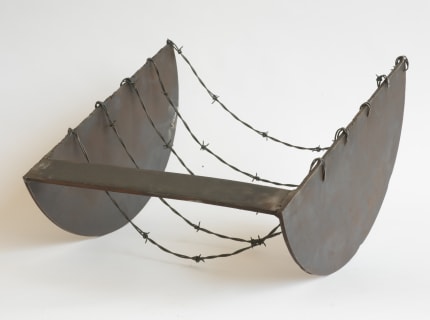At first glance, from a distance, his sculptures’ tortured, jutting and tangled formations make them seem like relics preserved in magma or dug up from vanished farming villages or prewar factories. Close up, they are vital and integrated, animated by an illusion of motion conveyed through the sculptor’s contortions of the steel and superimpositions of metal on metal — and metal into metal. These interlocking components are intensified by Edwards’ aggressive and imaginative play with their multiple, contradictory meanings. His current show at Alexander Gray Associates marks the largest exhibition of Edwards’ work since a major retrospective held in the same space in 2010.
Though his inspirations are drawn from both within and beyond the borders of the United States, Edwards’ biography is utterly American. Born in 1937, in Houston, Texas, and raised for a time in Dayton, Ohio, Edwards served in the naval reserves and earned a football scholarship to attend USC. He had taken up painting in high school, and then studied sculpture in the early 1960s under such diverse figures as Hal Gebhardt, Hans Burkhardt and Edward Ewing. While critics have often cited David Smith as his touchstone, the scholar Lowery Stokes Sims cites Edwards’ own statements that his chief influence was the sculptor Theodore Roszak. As in Roszak’s works, Edwards’ symbolic designs project outwardly or inwardly from the sculpture’s dense centers, consistently defying representation in order to connote kinetic energy and potentialities.
Edwards’ career breakthrough came with his Lynch Fragments , a series he began in the early 1960s and exhibited soon after in Los Angeles and Santa Barbara to immediate acclaim. That series, which he has continued over the decades, was initially inspired by the implosive canvases of Abstract Expressionism and the urban uprisings during the civil rights era, and it has provided the impetus and the scale for almost all of Edwards’ relief sculptures since, including most of the works, completed over the last thirty years, exhibited in this breathtaking show.
Despite its evocations of historical memory, Edwards’ work has always seemed fueled by ambivalences that have only deepened over the years, in part due to the artist’s immersion in other cultures. Starting in the late 1960s, Edwards developed countless friendships and collaborators in artistic communities in Nigeria, Gabon, Zimbabwe, and South Africa, as well as in Senegal, where he established a studio, spending several weeks each year working there during the 2000s.
In Edwards’ work, personal and communal significations operate in tandem. Edward’s hyper-individualized sculptures allude to a range of basic human activities, some of them productive, like agriculture, building, manufacturing and trade, and others disgraceful, like civic violence, warfare, torture and incarceration. Because of this, they produce global resonances even when, or especially when, their themes are localized or particularized.
This current show occupies two floors of the roomy Alexander Gray exhibition space. The ground floor features a series on rounded metal plates completed over the last ten years, many of which are Edwards’ conjurations of Senegal’s urban zones.
“MMOZ” (2005) is named after Mermoz, a district in Dakar near the spot where Edwards maintained a studio. Curved metal braces or plates, some of them resembling small horseshoes, are welded among bars of various thicknesses and joints. Within this intense synergy, a gold-coated lock or casing forms a strange talismanic focal point. The welded sculpture slopes downward as if it might melt off its circular base even as it retains its internal, angular logic. As in all of Edwards’ small scale reliefs, the eye is transfixed by a network of invisible links that create a pulsing unity among the welded components. You stand before it visually tracing the sculpture’s junctures and recesses, its knots and gaps, its unfolding and enfolding, a sense of motion highlighted by the liquid-like seam where the bristling body of the work is welded to the smooth base.
One of the most striking of the recent sculptures is “Kasangadila: For Francisco Romão Oliveira e Silva” (2004), a title explained in the exhibition catalogue as meaning “Thank you” in Kamanadu, with the dedication referring to the late Angolan leader who led the country’s rebellion against the Portuguese. That history speaks vehemently through steel. A large ring supported by welded spokes seems to form an informal frame, which itself contains a grooved cylinder, a smooth flat bar and a few chain links that nearly enclose yet another curved bar. Outside this circular framing protrudes a rail spike, and further down, a machete blade. Taken together these are talismans of agricultural traditions and industrialization as well as latent discord and violence, forming an ambivalent allegory of the country’s post-colonial situation. The sculpture’s machine-like composites seem frozen in time yet synchronized with some timeless, or ecstatic, dimension.
The gallery’s upper floor contains many more compressed relief sculptures, each a kaleidoscope of visual and emotional experiences. Except for three sculptures built on elegant, grid-like bases that were created for Edwards by Senegalese metalworker Yusuf N’Diaye, most of these works dominate their almost unseen bases, giving this section of the exhibition a special charge. These frontloaded, spiked, crenellated, baroque objects seem to burst through the white walls of the brightly lit gallery at perfectly corresponding heights and consistently precise distances from one another.

